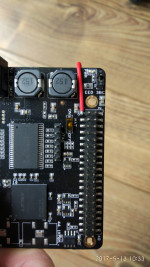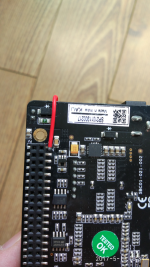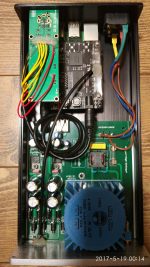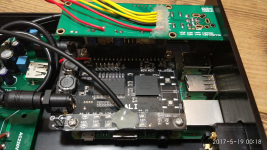grr...we are having problems with master mode (codec) at certain frequencies
Boss is working at 192Khz only.
Boss is working at 192Khz only.
grr...we are having problems with master mode (codec) at certain frequencies
Boss is working at 192Khz only.
Good luck! Keep faith. I know you will tackle the problem. You and the rest of the Allo team are very skilled.
Piggybacking e.g. Blackgates, which I still have around.
Curious how that works... I've not tried BG's paralleled with MLCC ceramic caps.
My most recent experiences are moving me away from ceramic caps, at least from the digital side of DACs and afterwards, and possibly everywhere in a DAC's circuit (except maybe around clocks or high-speed digital logic chips).
On my setup for the Piano 2.1 in 'twinned' mode, I wrote this in another thread:
DJ,
This setup is running an older version of pCP, 1.22.
In the pCP SqueezeLite configuration thread, I did use Soundcheck's preferred ALSA settings "65536:8:32:1", Buffer Size "50000:600000", Restrict Codec to "pcm,flac", & Priority Setting to 45. I'd try these first on your current pCP setup before trying it on your Kali.
Good luck!
Greg in Mississippi
P.S. I did try it with both Piano 2.1's I have here and both worked ok.
I've since tried this with PcP 3.2 & it works there too.
AND I've also tried this setup with a Boss DAC... and while it works, it just didn't sound very good to my ears & in my setup. I rather like the Boss in slave mode on a Kali with the Allo driver in PcP 3.2... and it is still good in master mode, though I prefer it in slave mode (same with the HFBD+P). But in slave mode with the generic I2S driver, it did not sound good.
Greg in Mississippi
My i2s to aes card need 3.3V.So I get 3.3V by this way!
But I have some problem.i2s to aes card wm8805 work on MCLK rate of 512fs, 256fs, 128fs and 64fs.when I play 44.1/48 with Kali Reclocker,MCLK rate is 1024fs. So it can't work, until It resample to 88.2/96 .
Can you find a solution to this problem?🙂




But I have some problem.i2s to aes card wm8805 work on MCLK rate of 512fs, 256fs, 128fs and 64fs.when I play 44.1/48 with Kali Reclocker,MCLK rate is 1024fs. So it can't work, until It resample to 88.2/96 .
Can you find a solution to this problem?🙂




Last edited:
Yesterday I received the first drop of a Piano driver patch - prepared by Allo - for testing it.
For now it'll introduce a "Dual Mono" and a "Dual Stereo" mode.
In general it works nicely. Modes are selected through alsamixer/amixer.
I do have some small issues with this or that though.
I'm quite positive that soon this nice update will hit the market.
Well done Allo!
For now it'll introduce a "Dual Mono" and a "Dual Stereo" mode.
In general it works nicely. Modes are selected through alsamixer/amixer.
I do have some small issues with this or that though.
I'm quite positive that soon this nice update will hit the market.
Well done Allo!
The sound quality is the best I have head in my system. My system is Burmester 961, 032, Northstar excelsio. The sound quality of Sparky and KALI is at least equivalent to a us dollars 10,000 CD transport. I am designing a external clock module of KALI for Pulasr Clock, it will improve more.
Attachments
Fantastic! Thanks for sharing
And your Pulsar Clock module for the Kali is a magnificent insanity that will repay your investment back in sound quality many times.
Sort of like my insanity of powering my best R-Pi player setup with nearly $1900 USD of power supplies:
- 4 Uptone Audio LPS-1 for IsolatorPi, Kali, and the 3.3V & 5V rails on the DAC
- A 50VA RCore + oversized soft recovery diodes + 2 15000uF Jensen 4-pole caps linear supply for the +-15V output stage
- A modified K&K low voltage 12Watt linear supply for the RPi.
Now that we have the Kali & the soon to be generally available isolator boards, the sound quality one can get from the lowly Pi will amaze!
Greg in Mississippi
And your Pulsar Clock module for the Kali is a magnificent insanity that will repay your investment back in sound quality many times.
Sort of like my insanity of powering my best R-Pi player setup with nearly $1900 USD of power supplies:
- 4 Uptone Audio LPS-1 for IsolatorPi, Kali, and the 3.3V & 5V rails on the DAC
- A 50VA RCore + oversized soft recovery diodes + 2 15000uF Jensen 4-pole caps linear supply for the +-15V output stage
- A modified K&K low voltage 12Watt linear supply for the RPi.
Now that we have the Kali & the soon to be generally available isolator boards, the sound quality one can get from the lowly Pi will amaze!
Greg in Mississippi
Fantastic! Thanks for sharing
And your Pulsar Clock module for the Kali is a magnificent insanity that will repay your investment back in sound quality many times.
Sort of like my insanity of powering my best R-Pi player setup with nearly $1900 USD of power supplies:
- 4 Uptone Audio LPS-1 for IsolatorPi, Kali, and the 3.3V & 5V rails on the DAC
- A 50VA RCore + oversized soft recovery diodes + 2 15000uF Jensen 4-pole caps linear supply for the +-15V output stage
- A modified K&K low voltage 12Watt linear supply for the RPi.
Now that we have the Kali & the soon to be generally available isolator boards, the sound quality one can get from the lowly Pi will amaze!
Greg in Mississippi
Where can buy the isolator boards? Ian?
I have ordered 5V10A LPS with R core transformer. I will get it next week. What kind power supplier do you cost for$1900 USD?
Linear Power Supply maybe not so expensive. My LPS cost me for 200 USD, buy from TeraDak. http://hifiss.com I will post my LPS when I get it.
Last edited:
Cyrilliu,
Of course these are 6 separate supplies, one of which is a +- supply.
See this thread by Ian for info on his IsolatorPi:
http://www.diyaudio.com/forums/pc-b...-i2s-dsd-isolator-hat-native-dsd-decoder.html
It should be available very soon... I've got a beta-test unit here and very happy with what it does.
You can add your interest for a board here:
http://www.diyaudio.com/forums/grou...hronous-i2s-s-pdif-fifo-kit-group-buy-48.html
The Uptone Audio LPS-1 UltraCap supplies provide either 3.3V/5V/7V at 1.1A and sell for about $400 USD each... more information here:
https://uptoneaudio.com/products/ultracap-lps-1
And on the Uptone Audio forum on Computer Audiophile.
They provide the benefit of the output power being fed from a source not connected to the AC line, eliminating noise that is transmitted through AC-connected power supplies. PLUS they are good supplies! (though not the best, but to beat them IMHO you're looking at the GREAT, but very high $ Paul Hynes supplies).
4 x $400 starts this at $1,600.
The K&K Audio Low Voltage Power Supplies can be seen here:
K&K Audio | Other kits
and the 12 Watt one sells for about $50.
I DIY'd the +-15V supply using an EBay 50VA RCore (~$50 USD), 4 over-spec'd diodes (~$20 USD), and the 2 47,000 Jensen 4-Pole filter caps (~$180), so about $250.
This gets up to $1,900. Cables, connectors, mountings will eat a bit more, but not much.
Really looking forward to seeing & hearing about your Pulsar adaptation of the Kali!
Greg in Mississippi
Of course these are 6 separate supplies, one of which is a +- supply.
See this thread by Ian for info on his IsolatorPi:
http://www.diyaudio.com/forums/pc-b...-i2s-dsd-isolator-hat-native-dsd-decoder.html
It should be available very soon... I've got a beta-test unit here and very happy with what it does.
You can add your interest for a board here:
http://www.diyaudio.com/forums/grou...hronous-i2s-s-pdif-fifo-kit-group-buy-48.html
The Uptone Audio LPS-1 UltraCap supplies provide either 3.3V/5V/7V at 1.1A and sell for about $400 USD each... more information here:
https://uptoneaudio.com/products/ultracap-lps-1
And on the Uptone Audio forum on Computer Audiophile.
They provide the benefit of the output power being fed from a source not connected to the AC line, eliminating noise that is transmitted through AC-connected power supplies. PLUS they are good supplies! (though not the best, but to beat them IMHO you're looking at the GREAT, but very high $ Paul Hynes supplies).
4 x $400 starts this at $1,600.
The K&K Audio Low Voltage Power Supplies can be seen here:
K&K Audio | Other kits
and the 12 Watt one sells for about $50.
I DIY'd the +-15V supply using an EBay 50VA RCore (~$50 USD), 4 over-spec'd diodes (~$20 USD), and the 2 47,000 Jensen 4-Pole filter caps (~$180), so about $250.
This gets up to $1,900. Cables, connectors, mountings will eat a bit more, but not much.
Really looking forward to seeing & hearing about your Pulsar adaptation of the Kali!
Greg in Mississippi
@cdsgames
I had some troubles with Kali and RPI 2 AND RPI 3 in combination with PicorePlayer V# 3.02 to 3.20
After many testing it seems everything is stable now. Disabling the buffer settings within PicorePlayer did the trick!!!!
So, if someone has troubles with music skipping ahead, without distortion, just trie to disable buffersettings or decrease them.
Hope this helps!!
Regards,
Alex
I had some troubles with Kali and RPI 2 AND RPI 3 in combination with PicorePlayer V# 3.02 to 3.20
After many testing it seems everything is stable now. Disabling the buffer settings within PicorePlayer did the trick!!!!
So, if someone has troubles with music skipping ahead, without distortion, just trie to disable buffersettings or decrease them.
Hope this helps!!
Regards,
Alex
A external clock board for KALI is in progress.
Wow, 🙂
It could be also keeped for less expensive Crystek CHD-957...
Why not just make one board to avoid the uf-l wire which add jitter on its own (around 190 pico second by 1" length, so 0.8 nano second with a classic 4" uf-l cable) ?
With the two pads on a main clock board but on the upper left corner to allow to stack it with soldering on the Kali board ? (I saw IanCanada makes plain board with empty space : for instance the MC Clock where the 3 LDO regs have empty space around it but the side towards the Inside of the board of course"
https://www.flickr.com/photos/135181977@N06/34857119345/in/album-72157681347089082/
(By the way I even ask myself why Ian don't allow its MC Clock to be stacked by direct connector on the MC Fifo to avoid flat cable and uf-l cable ?? maybe there are not pins or plugs matched at 50 ohms ?????.... but as the flat cable for I2S is not so common, why not ?! : just make the flat connector bigger for the MCLK signal near the I2S signal and overlapp the boards by stacking to reduce the EMI surfece and added jitter by length of the cables ?!)
But it should be very difficult to design, draw and solder with stacking !
I find the little adapter and clock-board pcbs very sumpathetic, asking myself if I could use it with the ANdrea Mori adapter for its OCXO Discroll board as well (dip 14 format as the Supra clock, the Crystek Ian's adapter, or Andrea Mori TWTMC afdapters made for Ian's clock board II)...
Very good Job Cyrilliu, bravo !
You need to dismantle the NDKs on the Kali or just cut the traces towards the biggest soldering trace ?
If CDSGAMES allow vias on the KALI II traces XO areas at the size on a DIP 14 spacing it could be even easier to fight against the jitter because the distance between the clock board and the final Flip/flop chip (I assume fifo chip can not do any thing after itself to fight against the jitter after its outside while the flip/flop is slaved by the clock yet ??? Sorry btw if I missunderstood !😱)
regards
Last edited:
Wow, 🙂
If CDSGAMES allow vias on the KALI II traces XO areas at the size on a DIP 14 spacing it could be even easier to fight against the jitter because the distance between the clock board and the final Flip/flop chip (I assume fifo chip can not do any thing after itself to fight against the jitter after its outside while the flip/flop is slaved by the clock yet ??? Sorry btw if I missunderstood !😱)
regards
Interesting. We will look into it.
Thanks,
Btw way I assume the main default of any stacking with Hats and pcb boards with high frequency clock is to match the 50 ohms impedance between the boards ?!
Here the uf-l or sma plugs have a big plus on their own while each inch of cable adds jitter : trade off I surmise and I don't know what is the main poison here if one has to choose between impedance matching or length of cables trade-off?!
Andrea Mori was brillant to allow to stack his adaptor for Ian's clock board with his clock board for AT/SC cut Crystal just by stacking them by two vias in vertical position: the vias of the boards overlapp eachselves and you just need a drop of solder into the vias or a golden pins to stack them : distance : 1 mm, the thickness of the board' vias !
Btw way I assume the main default of any stacking with Hats and pcb boards with high frequency clock is to match the 50 ohms impedance between the boards ?!
Here the uf-l or sma plugs have a big plus on their own while each inch of cable adds jitter : trade off I surmise and I don't know what is the main poison here if one has to choose between impedance matching or length of cables trade-off?!
Andrea Mori was brillant to allow to stack his adaptor for Ian's clock board with his clock board for AT/SC cut Crystal just by stacking them by two vias in vertical position: the vias of the boards overlapp eachselves and you just need a drop of solder into the vias or a golden pins to stack them : distance : 1 mm, the thickness of the board' vias !
Wow, 🙂
It could be also keeped for less expensive Crystek CHD-957...
Why not just make one board to avoid the uf-l wire which add jitter on its own (around 190 pico second by 1" length, so 0.8 nano second with a classic 4" uf-l cable) ?
With the two pads on a main clock board but on the upper left corner to allow to stack it with soldering on the Kali board ? (I saw IanCanada makes plain board with empty space : for instance the MC Clock where the 3 LDO regs have empty space around it but the side towards the Inside of the board of course"
https://www.flickr.com/photos/135181977@N06/34857119345/in/album-72157681347089082/
(By the way I even ask myself why Ian don't allow its MC Clock to be stacked by direct connector on the MC Fifo to avoid flat cable and uf-l cable ?? maybe there are not pins or plugs matched at 50 ohms ?????.... but as the flat cable for I2S is not so common, why not ?! : just make the flat connector bigger for the MCLK signal near the I2S signal and overlapp the boards by stacking to reduce the EMI surfece and added jitter by length of the cables ?!)
But it should be very difficult to design, draw and solder with stacking !
I find the little adapter and clock-board pcbs very sumpathetic, asking myself if I could use it with the ANdrea Mori adapter for its OCXO Discroll board as well (dip 14 format as the Supra clock, the Crystek Ian's adapter, or Andrea Mori TWTMC afdapters made for Ian's clock board II)...
Very good Job Cyrilliu, bravo !
You need to dismantle the NDKs on the Kali or just cut the traces towards the biggest soldering trace ?
If CDSGAMES allow vias on the KALI II traces XO areas at the size on a DIP 14 spacing it could be even easier to fight against the jitter because the distance between the clock board and the final Flip/flop chip (I assume fifo chip can not do any thing after itself to fight against the jitter after its outside while the flip/flop is slaved by the clock yet ??? Sorry btw if I missunderstood !😱)
regards
The four clock pad on KALI is in compliance with the Crystek CCHD-950 specifications, so I have to make a back side of a small adapter board equivalent to a back side of Crystek CCHD-950 (SMD). This is why there is no way to use a single board to complete the main reason for the external clock board.
I will need re-solder two clock on KALI before I install the small adapter board.
Attachments
Last edited:
I'm not sure the CCHD-950 is a good swap vs the NDK, but the better CCHD-957 maybe ! And of course the OCXO from Supratech is outside the competition for people who can afford them.
To me the CCHD-957 sounds not harsch has some have pointed out, it just is very transparent with a low noise floor : all is about the layout and the decoupling caps and powersupplies arounds. At least with the TDA1541A, I just don't know with an ESS chip or SD family chip !
To me the CCHD-957 sounds not harsch has some have pointed out, it just is very transparent with a low noise floor : all is about the layout and the decoupling caps and powersupplies arounds. At least with the TDA1541A, I just don't know with an ESS chip or SD family chip !
Last edited:
grr...we are having problems with master mode (codec) at certain frequencies
Boss is working at 192Khz only.
Great work Allo. You're bringing great quality audio to the mass for such a small outlay. I cant wait to get the Isolator board for my Rpi3+Boss Dac.
Good news The Boss is working at full 384Khz, but small driver change was needed
We will release the HAT for sale very soon.
We will release the HAT for sale very soon.
Good news The Boss is working at full 384Khz, but small driver change was needed
We will release the HAT for sale very soon.
This is great news! What a great job!
- Home
- Vendor's Bazaar
- New FIFO buffer for RPI/SBCs







